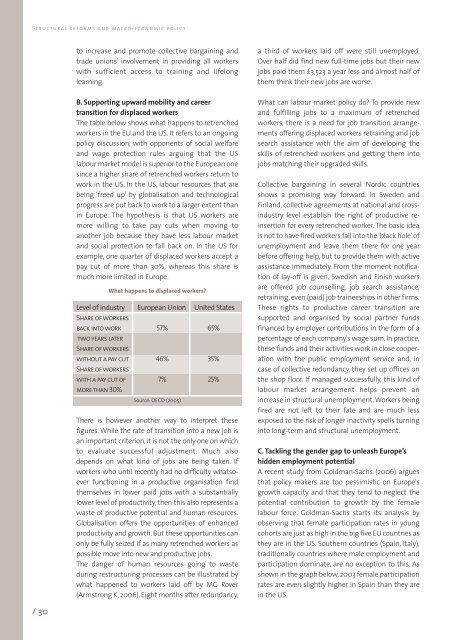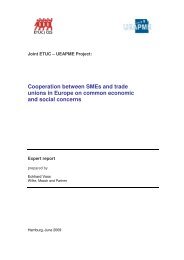Structural reforms and macro-economic policy - ETUC
Structural reforms and macro-economic policy - ETUC
Structural reforms and macro-economic policy - ETUC
You also want an ePaper? Increase the reach of your titles
YUMPU automatically turns print PDFs into web optimized ePapers that Google loves.
<strong>Structural</strong> <strong>reforms</strong> <strong>and</strong> <strong>macro</strong>-<strong>economic</strong> <strong>policy</strong><br />
/ 30<br />
to increase <strong>and</strong> promote collective bargaining <strong>and</strong><br />
trade unions' involvement in providing all workers<br />
with sufficient access to training <strong>and</strong> lifelong<br />
learning.<br />
B. Supporting upward mobility <strong>and</strong> career<br />
transition for displaced workers<br />
The table below shows what happens to retrenched<br />
workers in the EU <strong>and</strong> the US. It refers to an ongoing<br />
<strong>policy</strong> discussion, with opponents of social welfare<br />
<strong>and</strong> wage protection rules arguing that the US<br />
labour market model is superior to the European one<br />
since a higher share of retrenched workers return to<br />
work in the US. In the US, labour resources that are<br />
being ‘freed up’ by globalisation <strong>and</strong> technological<br />
progress are put back to work to a larger extent than<br />
in Europe. The hypothesis is that US workers are<br />
more willing to take pay cuts when moving to<br />
another job because they have less labour market<br />
<strong>and</strong> social protection to fall back on. In the US for<br />
example, one quarter of displaced workers accept a<br />
pay cut of more than 30%, whereas this share is<br />
much more limited in Europe.<br />
What happens to displaced workers?<br />
Level of industry European Union United States<br />
Share of workers<br />
back into work 57% 65%<br />
two years later<br />
Share of workers<br />
without a pay cut 46% 35%<br />
Share of workers<br />
with a pay cut of 7% 25%<br />
more than 30%<br />
Source: OECD (2005)<br />
There is however another way to interpret these<br />
figures. While the rate of transition into a new job is<br />
an important criterion, it is not the only one on which<br />
to evaluate successful adjustment. Much also<br />
depends on what kind of jobs are being taken. If<br />
workers who until recently had no difficulty whatsoever<br />
functioning in a productive organisation find<br />
themselves in lower paid jobs with a substantially<br />
lower level of productivity, then this also represents a<br />
waste of productive potential <strong>and</strong> human resources.<br />
Globalisation offers the opportunities of enhanced<br />
productivity <strong>and</strong> growth. But these opportunities can<br />
only be fully seized if as many retrenched workers as<br />
possible move into new <strong>and</strong> productive jobs.<br />
The danger of human resources going to waste<br />
during restructuring processes can be illustrated by<br />
what happened to workers laid off by MG Rover<br />
(Armstrong K, 2006). Eight months after redundancy,<br />
a third of workers laid off were still unemployed.<br />
Over half did find new full-time jobs but their new<br />
jobs paid them £3,523 a year less <strong>and</strong> almost half of<br />
them think their new jobs are worse.<br />
What can labour market <strong>policy</strong> do? To provide new<br />
<strong>and</strong> fulfilling jobs to a maximum of retrenched<br />
workers, there is a need for job transition arrangements<br />
offering displaced workers retraining <strong>and</strong> job<br />
search assistance with the aim of developing the<br />
skills of retrenched workers <strong>and</strong> getting them into<br />
jobs matching their upgraded skills.<br />
Collective bargaining in several Nordic countries<br />
shows a promising way forward. In Sweden <strong>and</strong><br />
Finl<strong>and</strong>, collective agreements at national <strong>and</strong> crossindustry<br />
level establish the right of productive reinsertion<br />
for every retrenched worker. The basic idea<br />
is not to have fired workers fall into the ‘black hole’ of<br />
unemployment <strong>and</strong> leave them there for one year<br />
before offering help, but to provide them with active<br />
assistance immediately. From the moment notification<br />
of lay-off is given, Swedish <strong>and</strong> Finish workers<br />
are offered job counselling, job search assistance,<br />
retraining, even (paid) job traineeships in other firms.<br />
These rights to productive career transition are<br />
supported <strong>and</strong> organised by social partner funds<br />
financed by employer contributions in the form of a<br />
percentage of each company's wage sum. In practice,<br />
these funds <strong>and</strong> their activities work in close cooperation<br />
with the public employment service <strong>and</strong>, in<br />
case of collective redundancy, they set up offices on<br />
the shop floor. If managed successfully, this kind of<br />
labour market arrangement helps prevent an<br />
increase in structural unemployment. Workers being<br />
fired are not left to their fate <strong>and</strong> are much less<br />
exposed to the risk of longer inactivity spells turning<br />
into long-term <strong>and</strong> structural unemployment.<br />
C. Tackling the gender gap to unleash Europe’s<br />
hidden employment potential<br />
A recent study from Goldman-Sachs (2006) argues<br />
that <strong>policy</strong> makers are too pessimistic on Europe's<br />
growth capacity <strong>and</strong> that they tend to neglect the<br />
potential contribution to growth by the female<br />
labour force. Goldman-Sachs starts its analysis by<br />
observing that female participation rates in young<br />
cohorts are just as high in the big five EU countries as<br />
they are in the US. Southern countries (Spain, Italy),<br />
traditionally countries where male employment <strong>and</strong><br />
participation dominate, are no exception to this. As<br />
shown in the graph below, 2003 female participation<br />
rates are even slightly higher in Spain than they are<br />
in the US.

















